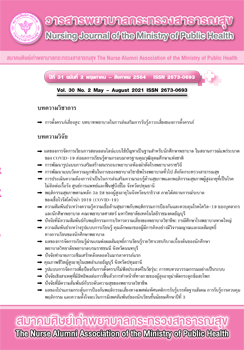The Effects of a Booster Program for Sexual Risk Behavior Prevention on Attitude, Subjective Norm, Perceived Behavior Control and Sexual Abstinence Intention of the 9th Graders
Main Article Content
Abstract
Sexual risk behaviors of adolescents are causes of teenage pregnancy and sexually transmitted diseases. They are considered to be public health problems that require urgent remediation. If sexual abstinence could be achieved, problems from sexual risk behaviors among adolescents could effectively be reduced. This quasi-experimental study aimed to examine the effect of a booster program for sexual risk behavior prevention on attitudes, subjective norms, perceived behavioral control, and sexual abstinence intention of ninth graders. Purposive sampling was employed, and the participants from two schools were those who previously attended “the Sexual Risk Behavior Prevention Program for Sixth Graders” 3 years earlier. The sample included 27 participants in a control group and 27 in an experimental group. The experimental booster instrument was an activity plan. Data-collection instruments were questionnaires on general information, attitudes towards sexual behaviors, subjective norms about sexual behaviors, and perceived behavioral control. Data were analyzed using descriptive statistics, Independent t-test, Mann Whitney U-test, Paired t-test and Wilcoxon signed rank test. Results revealed that 1) after the experiment, the participants with the booster program for sexual risk behavior prevention demonstrated higher means of sexual abstinence intention than before the experiment with statistical significance (p<.05), but indicated no significant difference in means of attitudes, subjective norms, and perceived behavioral control with statistical significance (p>.05); and 2) the participants with the booster program showed higher means of attitudes, subjective norms, perceived behavioral control, and sexual abstinence intention than those in the control group with statistical significance (p<.05). Based on this study, it is recommended that for the booster program to promote desirable behaviors and outcomes, it should be consistently implemented since such behaviors might diminish over time.
Article Details
บทความและรายงานวิจัยในวารสารพยาบาลกระทรวงสาธารณสุข เป็นความคิดเห็นของ ผู้เขียน มิใช่ของคณะผู้จัดทำ และมิใช่ความรับผิดชอบของสมาคมศิษย์เก่าพยาบาลกระทรวงสาธารณสุข ซึ่งสามารถนำไปอ้างอิงได้
References
2. Panton JE, Maaks DL. Developmental management of adolescent and young adults. 7th. Washington: Elsevier;2019.
3. Allem B, Waterman DH. Stages of adolescence. [Internet]. 2019 [cited 2020 Feb 20]. Available from:
https://www.healthychildren.org/English/ages-stages/teen/Pages/Stages-of-Adolescence.aspx
4. Association of Maternal & Child Health Programs. developmental tasks and attributes of middle adolescence (ages 15–17 years). [Internet]. 2013 [cited 2020 Feb 23]. Available from: http://www.amchp.org/
programsandtopics/AdolescentHealth/projects/Documents/SAHRC%20AYADevelopment%20MiddleAdolescence.pdf
5. Sukrat B. Teen pregnancy: policy, operational guidelines, monitoring and evaluation. Nonthaburi: The Agricultural Co-operative Federation of Thailand., LTD. (ACFT);2014.
6. World Health Organization. [Internet]. 2014 [cited2016 April 7]. Available from: http://www.who.int/
mediacentre/factsheets/fs364/en/
7. Unicef. Situation analysis of adolescent pregnancy in Thailand synthesis report 2015. [Internet]. 2015 [cited2016 April 10]. Available from: https://is.gd/5Rks2u
8. Health Intervention and Technology Assessment Program. Adolescent pregnancy in Thailand. [Internet]. 2013 [cited2016 Jan 28]. Available from http://www.hitap.net/: https://www.m-society.go.th/article_attach/11829/16120.pdf.
9. Phuphaibul R, Kongsaktrakul C, Chokprajakchad M, Chantarachot J, Techajhong A, Ariyanuchitkul S. Effects of the Sexual Threat Behavior Prevention Program on Sex-Abuse Intention of Prathomsuksa 6. Journal of nursing science and health 2016:113-23.
10. Pusuwun S, Wongyai K, Leekuan P. Effects of skill development for prevention of sexual risk behavior on perceived self-efficacy and sexual risk behavior among female adolescent. Nursing Journal2013:68-79.
11. Whisman MA. The efficacy of booster maintenance sessions in behavior therapy: Review and methodological critique. Clinical Psychology Review 1990:155-70.
12. Patterson GR. Retraining of aggressive boys by their parents: review of recent literature and follow-up evaluation. Canadian Psychiatric Association Journal 1974;l:142-58.
13. Tolan PH, Gorman-Smith D, Henry D, Schoeny M. The benefits of booster interventions: evidence from a family-focused prevention program. Prevention Science 2009:287–297.
14. Phuphaibul R et al. Game Kid…kid. [Computer game]. Bangkok: Thai Population Development Project by the Faculty of Medicine Ramathibodi Hospital Mahidol University;2014.
15. Ajzen I. The theory of planned behavior. Organizational Behavior and Social Human Decision Processes 1991;50:179-211.
16. Faul F, Erdfelder E, Lang AG, Buchner A. G*Power 3: A flexible statistical power analysis program for the social, behavioral, and biomedical sciences. Behavior Research Methods2007;39:175-91.
17. Neranon W, Phuphaibul R, Kongsaktrakul C. Effects of the activity package computer game media on attitudes, norms and perceived behavior control on sexual abstinence of 7th grade students. Kuakarun Journal of Nursing 2018;25(1):73-89.
18. Fongkaew W, Lirtmunlikaporn S, Chontawan R, Chanprasit C, Baosoung C. research report of behavior planning program development for prevention and reduction of risk behavior in adolescents phase i: tool development and behavior survey. Nontaburi: Office of the Health Promotion Foundation.2006.
19. Suthutvoravut S, Duangjai N. Comparison of knowledge, attitude and sexual behavior between high school students who did and did not participated in Friend corner project. Ramathibodi Medical Journal 2015;38(2):88-9.
20. Kanokthavorntham A, Lalognum N. The development of computer-assisted instruction by using the Gagne’s nine events of instruction on sex education for mathayomsuksa2 students. Journal of Education Naresuan University 2017;21(4):329-41.
21. Witayapichetsakul S. Effect of a health education program on attitude, subjective norm, perceived behavioral control, as well as intention of preventing premature pregnancy and sexually transmitted infection of high school students in Chonburi province. The Southern College Network Journal of Nursing and Public Health 2020;7(1):215-226.
22. Sangchart E, Duangsong R. The effects of health education program with electronic media (facebook) on skill development for adolescent pregnancy prevention among grade 7 students. Journal of the office of DPC 7 Khon Kaen 2016;23(1):96-104.

